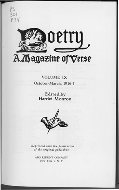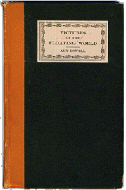The
Kuzmin
Collection
§
Dalhousie University
§
Halifax,
Nova Scotia,
Canada
etc@dal.ca Last updated
http://etc.dal.ca/
902-494-2319 (fax)
7 January 1999
Dalhousie University
Dalhousie University Libraries
DISCLAIMER
The Electronic Text Centre is a project of the Dalhousie Electronic Text Working Group, with participation from Dalhousie's Killam Library, the School of Library and Information Studies, the Department of English, and Academic Computing Services.
Dalhousie University


Fuji in a Saucer: The Lowell Poem
The poem first appeared in the magazine Poetry in March, 1917, and again in
slightly modified form in Lowell's anthology titled Pictures of the
Floating World, published in 1919.
1917 Version |
1919 Version |
Foreword to Pictures of the Floating World,1919
1917 Version | ||
|
Amy Lowell Poetry, Vol. IX, March 1917
Being thirsty,
|  | |
1919 Version | ||
|
Amy Lowell Pictures of the Floating World, 1919
BEING thirsty,
|

| |
FOREWORD
The march of peoples is always toward the West, wherefore, the earth being round, in time the West must be East again. A startling paradox, but one which accounts for the great interest and inspiration that both poets and painters are discovering in Oriental art. The first part of this book represents some of the charm I have found in delving into Chinese and Japanese poetry. It should be understood, however, that these poems, written in a quasi-Oriental idiom, are not translations except in a very few instances all of which have been duly acknowledged in the text.
In the Japanese "Lacquer Prints," the hokku pattern has been more closely followed than has any corresponding Chinese form in the "Chinoiseries"; but, even here, I have made no attempt to observe the syllabic rules which are in integral part of all Japanese poetry. I have endeavoured only to keep the brevity and suggestion of the hokku, and to preserve it within its natural sphere. Some of the subjects are purely imaginary, some are taken from legends or historical events, others owe their inception to the vivid, realistic colour-prints of the Japanese masters, but all alike are peculiar to one corner of the globe and, for the most part, to one epoch the eighteenth century.
The second half of the volume, "Planes of Personality," consists of lyrical poems, deriving from everywhere and nowhere as is the case with all poetry, and needing no introduction. They have been written at various times during the last five years the earliest, immediately after the publication of "Sword Blades and Poppy Seed"; the most recent, only yesterday. They are here collected for the first time, since the scheme of my last two books of poetry, "Men, Women and Ghosts" and "Can Grande's Castle," necessarily forbade their inclusion in those volumes.
AMY LOWELL
BROOKLINE, MASS.
April 27, 1919

